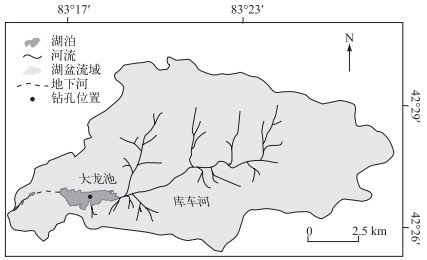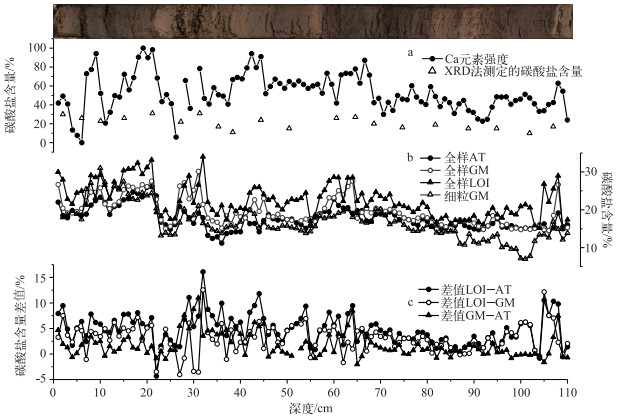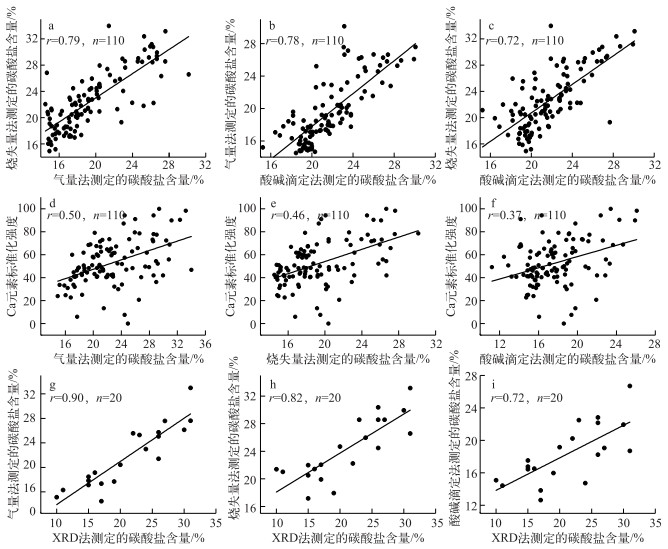湖泊沉积物中的碳酸盐含量是区域气候和环境重建研究中的常用指标[1-6].目前碳酸盐含量测定方法多样[7-10],常见的有烧失量法[10]、气量法[11]、酸碱滴定法[12]和X衍射(XRD)法[13-14].由于烧失量法和气量法的操作简单,这2种方法广泛应用于碳酸盐含量测定[10, 15-20],酸碱滴定法也应用于许多研究中[6, 12, 21],但是每种方法具有不同精度和分析技巧.对上述3种测定方法均有讨论[12, 15-16],然而缺少对同一沉积序列样品同时使用这3种测定方法的比较,不利于研究者选择适合的测定方法.本文选择新疆天山大龙池短钻(DLC12)样品,采用烧失量法、气量法和酸碱滴定法分别测定其碳酸盐含量,并比较不同测定方法得到的碳酸盐含量结果,对每种方法的有效性和优缺点进行评价.
1 研究区域大龙池(42°26′~42°27′N,83°16′~83°18′E,海拔2400 m)位于天山南坡河谷中(图 1),距离新疆库车市150 km.大龙池由发源于高山的冰雪融水河流补给,属淡水湖泊.入湖河流位于湖泊东部,大龙池西南方向有一小龙池,通过地下河与大龙池连通.小龙池西部有一条瀑布流入库车河支流.大龙池流域面积2 km2,最大长度2500 m,最大宽度1000 m.流域植被以针叶林为主(主要是云杉),海拔3000 m以下发育良好.最近的气象站位于库车县,年平均气温、降水量和蒸发量分别为11.3℃、76.1 mm和2219.4 mm[22].

|
图 1 大龙池的地理位置及其流域 Fig.1 The location and catchment of Lake Dalongchi |
2012年8月,利用活塞钻在湖心水深4.5 m处获得110 cm短钻(DLC12)岩芯沉积物.现场用细针管吸出岩芯顶部的水,用橡胶塞密封岩芯管两端以防止在运输途中岩芯发生扰动.在实验室内用荷兰生产的Avaatech XRF岩芯扫描仪对岩芯进行扫描,得到Ca元素强度(n=107)和岩芯照片(图 2).扫描后岩芯按1 cm间隔分样,冷冻干燥后备用.

|
图 2 结果对比 Fig.2 Results comparsion (a:Ca元素强度标准化值;XRD法测定的碳酸盐含量,b:3种方法测定的全样碳酸盐含量和气量法测定的细粒碳酸盐含量,c:每2种方法之间测定的碳酸盐含量差值,AT:酸碱滴定法,GM:气量法,LOI:烧失量法) (a:the normalized Ca element intensity; the bulk carbonate content by XRD, b:the bulk carbonate content by three methods and fine-grained sediments by gasometric method, c:the difference of carbonate contents among each method, AT:acid-based titration, GM:gasometric, LOI:loss on ignition) |
酸碱滴定法的实验过程[23]:滴定前先进行0.1 mol/L NaOH溶液的配制和标定及HCl溶液的配制.称取约0.1 g研磨后的样品,至于100 ml锥形瓶中,加入10 ml盐酸溶液以及2~3滴酚酞指示剂.待样品与盐酸溶液充分反应后,用NaOH溶液滴定,至溶液变红,摇匀后红色又消失表示达到滴定终点,记录消耗的NaOH体积.不加样品进行空白实验,记录消耗的NaOH体积.滴定法的碳酸盐含量计算公式为:
| $ W = \frac{{\left( {{V_0}-{V_1}} \right) \cdot {C_{{\rm{NaOH}}}} \cdot F}}{m} \times 100 $ | (1) |
式中,W为碳酸盐含量(%);CNaOH为NaOH溶液浓度(mol/L);V0为空白实验消耗NaOH溶液的体积(ml);V1为NaOH溶液与剩余盐酸反应消耗的体积(ml);m为样品质量(g);F取值0.05004,为消耗1 ml浓度为1 mol/L NaOH溶液所相当的CaCO3的量(g).
烧失量法实验过程参考文献[10].烧失量法计算碳酸盐含量的公式为:
| $ LO{I_{1000}} = \left( {\frac{{D{W_{550}}-D{W_{1000}}}}{{D{W_{105}}}}} \right) \times 100 $ | (2) |
式中,LOI1000为1000℃时的烧失量(%);DW550为550℃时消耗有机质的剩余样品干重(g);DW1000为1000℃燃烧后的剩余样品干重(g);DW105为105℃消耗水分的剩余样品干重(g);1000℃的烧失量乘以2.27即为样品的碳酸盐含量.
气量法使用Bascomb碳酸盐计[24],实验过程如下:首先检查装置的气密性,再称取约0.2 g研磨后的样品放入锥形瓶中,然后加入1:3的盐酸溶液.用坩埚钳夹住锥形瓶并缓慢摇动直至滴定管液面不再变化,把收集的气体存储在密封的滴定管内,让两支滴定管液面持平,滴定管前后的差值即为样品产生的二氧化碳体积[11, 15].记录实验过程中的温度与气压.其中气量法测定的细颗粒为全样过360目筛湿筛后,低温烘干获得.气量法计算碳酸盐含量的公式如下:
| $ W = \frac{{0.16 \cdot P \cdot V \cdot 0.75}}{{m \cdot \left( {273 + T} \right)}} $ | (3) |
式中,0.16为相关系数;0.75为大气压单位从hPa到mmHg的转换系数;273为摄氏度和华氏度的差值;P为当时的大气压强(hPa);m为干燥后样品的重量(g);T为摄氏温度(℃);V为收集到的气体体积(ml).
为评估3种方法测定的碳酸盐含量,自DLC12岩芯沉积物顶部按大约5 cm间隔共选取20个样品,做XRD分析.制片后的样品由荷兰生产的X'Pert Pro MPD测试得到矿物种类与相对百分含量.实验条件为:电压40 kV、电流40 mA;Cu靶;步长0.0170;步长时间20.0242. XRD测定的碳酸盐含量由碳酸盐矿物(方解石、文石与白云石)含量相加得到[7].上述实验均在兰州大学西部环境教育部重点实验室完成.
3 结果大龙池岩芯DLC12主要由粉砂和黏土组成,黑色泥间隔出现(图 2). XRD测试结果显示大龙池岩芯沉积物的矿物主要有石英、方解石、白云石、绿泥石、长石等,碳酸盐矿物中未出现文石,主要为方解石,白云石含量一般在2 % ~5 %. XRF扫描的Ca元素强度经过离差标准化处理,其与XRD得到的碳酸盐含量不具有可比性(图 2a). 3种方法测定的全样碳酸盐含量具有一致性,从岩芯的底部向顶部呈增加趋势(图 2b).烧失量得到的全样碳酸盐含量最高,较滴定法得到的碳酸盐含量平均约高5 %,较气量法得到的结果平均约高3 %;气量法和滴定法得到的碳酸盐含量较为接近,平均差值不到2 % (范围和平均值见表 1).细粒碳酸盐含量通常比全样碳酸盐含量偏低约3 % (图 2b). 3种方法测定的碳酸盐含量两两之间的差值范围为0~5 %,少数层位的差值较大,超过了10 % (如岩芯30、42、60 cm附近及岩芯下部105~109 cm)(图 2c).
| 表 1 3种方法测定的碳酸盐含量及其差值的范围、平均值和方差 Tab.1 Range, average and variance of carbonate content and differences among each method |
气量法和滴定法测定的全样碳酸盐含量之间的方差最小(表 1),表明这2种方法测定的结果更稳定,可能是因为这2种方法利用了相同的化学原理.烧失量法测定的碳酸盐含量通常要比实际值高些,可能是加热过程中部分非碳酸盐矿物分解影响了结果.气量法测定的细颗粒碳酸盐含量较全样平均低3 %,表明少量的碳酸盐赋存于粗颗粒沉积物中. 3种方法测定的全样碳酸盐含量之间的相关系数较高,其中气量法与烧失量法之间相关系数最高(r=0.79,图 3a),气量法与滴定法次之(图 3b),这表明气量法测定的碳酸盐含量与另外2种方法之间更加具有可比性,因此气量法测定的结果更合理.岩芯中20个样品XRD法测定的碳酸盐含量与气量法、烧失量和滴定法测定的全样碳酸盐含量相关系数分别为0.90、0.82和0.72(图 3g、h和i).

|
图 3 3种方法测定的碳酸盐含量之间相关性及其与XRF扫描Ca元素强度值和XRD结果间的相关性 Fig.3 Correlations among carbonate content determined by the three methods, Ca element intensity by XRF, and carbonate content by XRD |
通过对比分析,归纳了3种方法测定碳酸盐含量的优缺点(表 2).烧失量常被用来粗略估计沉积物的碳酸盐含量[10]. Oliver等发现影响烧失量精度的因素有很多,例如加热后、称量前暴露在空气中时间的长短、坩埚在马弗炉中的位置、样品的体积大小等[25].同时烧失量需要的样品量大,测定过的样品不可重复利用,测定精度随环境变化而改变,因此应用该方法前必须充分了解各种可能产生误差的因素(表 2).气量法可以比较准确地测定各种样品的碳酸盐含量,其绝对误差仅为0.5 % [15].自1952年Bien[11]提出气量法以来,许多学者对气量法测定碳酸盐含量作了详尽阐述[8-9, 15].气量法实验涉及CO2气体的产生和气体体积的测量[15],只要仪器的气密性足够好,得出碳酸盐含量的可信度较高.酸碱滴定是化学分析中经典的方法,但该方法也只能得到近似的结果,这是由于样品前处理过程、滴定过程、NaOH标定以及空白实验存在误差(表 2)[12],加上滴定过程中指示剂颜色判定具有一定难度,不同的实验人员判定的滴定结束时间会不同,也会产生误差.气量法和酸碱滴定法是利用盐酸与沉积物中的碳酸盐反应来测定碳酸盐含量,然而常温下白云石与盐酸可能不能反应完全,因此当沉积物中含有白云石时,这2种方法均会产生误差[26]. XRD法也是一种较好的测定湖泊沉积物碳酸盐含量的方法,该方法能够检测出样品中矿物的种类和相对百分含量,缺点是精度相对较低、费用较高[7, 13].尽管如此,作为仪器测定(系统误差相对稳定)结果,仍可以用来评估本文3种方法测定的结果.气量法测定的结果与XRD测定结果之间的相关性最高(r=0.90,图 3g),表明气量法测定的结果更接近真实值.滴定法结果与XRD结果间的相关性最低(r=0.72,图 3i),表明该方法因操作难度大而容易产生较大的误差.
| 表 2 3种测量碳酸盐含量方法的优缺点 Tab.2 Advantages and disadvantages of three methods |
有研究用岩芯XRF扫描的Ca元素强度来大致表示沉积物中碳酸盐含量的变化[27-28].本文DLC12孔的XRF扫描结果(图 2a)与3种方法测定的碳酸盐含量变化趋势的确类似,其中气量法结果与扫描的Ca元素强度值之间也有较好的相关性(图 3d),但这仅表明DLC12孔沉积物中含Ca元素的矿物以碳酸钙为主,因XRD结果显示该湖沉积物矿物种类较简单.若湖泊沉积物中含Ca矿物较为复杂时,XRF扫描的Ca元素强度值与碳酸盐含量间这种相关性就不一定存在.因此使用XRF扫描的Ca元素代表沉积物中碳酸盐含量时,仍需要谨慎,至少需要分析沉积物中的矿物种类,并确定其中的含Ca矿物以碳酸钙为主时方可使用.
本文DLC12孔沉积物来自淡水湖泊,淡水湖泊与封闭半封闭的咸水湖泊沉积物中碳酸盐的差别主要是其中文石矿物的含量.淡水湖泊沉积物中很少有文石,DLC12孔沉积物中XRD分析未检测到文石,而咸水湖泊因水体中Mg离子含量较高,沉积物中有一定含量的文石[13].文石与方解石在常温常压下化学性质相似[37].因此气量法对一般的咸水湖泊沉积物可以适用.但在干旱-半干旱地区的一些咸水湖泊中,也会形成自生的白云石,这在现代及全新世湖泊沉积物中均有报到[38-40].因此若沉积物中白云石含量较高时,气量法测定方法可能需要改进.
5 结论用3种方法测定大龙池岩芯沉积物碳酸盐含量,结果显示3种方法测定的结果随岩芯深度的变化趋势一致,其中烧失量法较气量法和滴定法测定的结果分别平均偏高约5 %和3 %,可能为沉积物样品中碳酸盐以外的矿物在加热中分解所致;气量法和滴定法结果较为接近,平均差值在2 %以内;气量法测定的全样较细颗粒组分碳酸盐含量偏高约3 %,表明少量的碳酸盐赋存于粗颗粒中;气量法测定的全样碳酸盐含量与XRD法测量结果相关性最高,表明气量法结果更接近真实值.使用XRF扫描的Ca元素强度值表征湖泊沉积物中碳酸盐含量时,需要谨慎,与其中含Ca矿物成分有关.考虑到酸碱滴定法操作难度较大且易导致误差,烧失量法通常会高估碳酸盐含量且需要较大的样品量,综合实验精度、测定时间和费用等因素,气量法可能是普通湖泊沉积物碳酸盐含量测定的优先选择.
致谢: 兰州大学西部环境教育部重点实验室张晓楠、吴铎参加了野外工作,穆德芬高级实验师为本文提供气量法测量装置,特此致谢.| [1] |
Pueyo JJ, Sáez A, Giralt S et al. Carbonate and organic matter sedimentation and isotopic signatures in Lake Chungará, Chilean Altiplano, during the last 12.3kyr.. Palaeogeography, Palaeoclimatology, Palaeoecology, 2011, 307(1/2/3/4): 339-355. DOI:10.1016/j.palaeo.2011.05.036 |
| [2] |
Chen Dou, Ma Xueyang, Zhang Yuzhi et al. Environmental changes during the past 400 years documented by a short core from Lake Gahai, eastern Qaidam Basin. J Lake Sci, 2015, 27(4): 735-744. [陈豆, 马雪洋, 张玉枝等. 柴达木盆地东部尕海短钻岩芯记录的过去近400a区域环境变化. 湖泊科学, 2015, 27(4): 735-744. DOI:10.18307/2015.0423] |
| [3] |
Xu H, Ai L, Tan L et al. Stable isotopes in bulk carbonates and organic matter in recent sediments of Lake Qinghai and their climatic implications. Chemical Geology, 2006, 235(3/4): 262-275. DOI:10.1016/j.chemgeo.2006.07.005 |
| [4] |
Ji S, Xingqi L, Sumin W et al. Palaeoclimatic changes in the Qinghai Lake area during the last 18, 000 years. Quaternary International, 2005, 136(1): 131-140. DOI:10.1016/j.quaint.2004.11.014 |
| [5] |
Li Shijie, Wang Xiaotian, Xia Weilan et al. The little ice age climate fluctuations derived from lakes ediments of Goulucuo, Qinghai-Xizang Plateau. Quaternary Sciences,, 2004, 24(5): 578-584. [李世杰, 王小天, 夏威岚等. 青藏高原苟鲁错湖泊沉积记录的小冰期气候变化. 第四纪研究, 2004, 24(5): 578-584. DOI:10.3321/j.issn:1001-7410.2004.05.015] |
| [6] |
Shen Ji, Zhang Enlou, Xia Weilan. Records from lake sediments of Lake Qinghai tomirror climatic and environmental changes of the past about 1000 years. Quaternary Sciences,, 2001, 21(6): 508-513. [沈吉, 张恩楼, 夏威岚. 青海湖近千年来气候环境变化的湖泊沉积记录. 第四纪研究, 2001, 21(6): 508-513. DOI:10.3321/j.issn:1001-7410.2001.06.006] |
| [7] |
Yang Bo, Liu Xingqi, Wang Yongbo. Carbonate contents of lake sediments determined by XRD method. J Lake Sci, 2014, 26(4): 637-640. [杨波, 刘兴起, 王永波. 湖泊沉积物碳酸盐含量的XRD半定量分析. 湖泊科学, 2014, 26(4): 637-640. DOI:10.18307/2014.0420] |
| [8] |
Yu Huifu. Situation and comparison of carbonate detection methods. Marine Geology Letters, 2007, 23(1): 35-39. [郁慧福. 碳酸盐测定方法现状及方法比较. 海洋地质动态, 2007, 23(1): 35-39. DOI:10.3969/j.issn.1009-2722.2007.01.010] |
| [9] |
Müller G, Heidelberg MG. A simple device for the determination of carbonate content in sediment, soils, and other materials. Neues Jahrbuch für Mineralogie-Monatshefte, 1971, 10: 466-469. |
| [10] |
Dean WE. Determination of carbonate and organic matter in calcareous sediments and sedimentary rocks by loss on ignition: Comparison with other methods. Journal of Sedimentary Research, 1974, 44(1): 242-248. DOI:10.1111/j.1365-2389.1964.tb00247.x |
| [11] |
Bien GS. Chemical analysis methods. California: University of California, 1952, 52-58. |
| [12] |
Lu Lijun, Cai Yuman, Hou Pengfei. Uncertainty evaluation of analytical results for carbonate in natural Gypsum samples by acid-base titration method. Rock and Mineral Analysis, 2008, 27(3): 211-214. [陆丽君, 蔡玉曼, 侯鹏飞. 酸碱滴定法测定天然石膏中碳酸盐的不确定度评定. 岩矿测试, 2008, 27(3): 211-214. DOI:10.3969/j.issn.0254-5357.2008.03.013] |
| [13] |
Yao Bo, Liu Xingqi, Wang Yongbo et al. Late Holocene climatic changes revealed by mineralogical records from lacustrine core KS-2006 from Lake Kusai in the Hoh Xil area, northern Tibetan Plateau. J Lake Sci, 2011, 23(6): 903-909. [姚波, 刘兴起, 王永波等. 可可西里库赛湖KS-2006孔矿物组成揭示的青藏高原北部晚全新世气候变迁. 湖泊科学, 2011, 23(6): 903-909. DOI:10.18307/2011.0612] |
| [14] |
Liu Xingqi, Shen Ji, Wang Sumin et al. A 16000-year paleoclimatic record derived from authigenetic carbonate of lacustrine sediment in Qinghai Lake. Geological Journal of China Universities, 2003, 9(1): 38-46. [刘兴起, 沈吉, 王苏民等. 16ka以来青海湖湖相自生碳酸盐沉积记录的古气候. 高校地质学报, 2003, 9(1): 38-46. DOI:10.3969/j.issn.1006-7493.2003.01.005] |
| [15] |
Ren Shaofang, Zheng Xiangmin, Ai Dongsheng et al. The improvement of carbonate content of the Xiashu Loess by measuring gas volume method. Research and Exploration in Laboratory, 2014, 33(3): 8-12. [任少芳, 郑祥民, 艾东升等. 气量法测定下蜀黄土碳酸钙含量的改进. 实验室研究与探索, 2014, 33(3): 8-12. DOI:10.3969/j.issn.1006-7167.2014.03.003] |
| [16] |
Wang Q, Li Y, Wang Y. Optimizing the weight loss-on-ignition methodology to quantify organic and carbonate carbon of sediments from diverse sources. Environmental Monitoring and Assessment, 2011, 174(1/2/3/4): 241-257. DOI:10.1007/s10661-010-1454-z |
| [17] |
Huang CC, Pang J, Su H et al. Holocene environmental change inferred from the loess-palaeosol sequences adjacent to the floodplain of the Yellow River, China. Quaternary Science Reviews, 2009, 28(25/26): 2633-2646. DOI:10.1016/j.quascirev.2009.05.024 |
| [18] |
Li Shufeng, Yan Shun, Kong Zhaocheng et al. Diatom records and environmental changes of the Dongdaohaizi area in Urumqi, Xinjiang. Arid Land Geography, 2005, 28(1): 81-87. [李树峰, 阎顺, 孔昭宸等. 乌鲁木齐东道海子剖面的硅藻记录与环境演变. 干旱区地理, 2005, 28(1): 81-87. DOI:10.3321/j.issn:1000-6060.2005.01.015] |
| [19] |
Bendell-Young LI, Thomas CA, Stecko JRP. Contrasting the geochemistry of oxic sediments across ecosystems: A synthesis. Applied Geochemistry, 2002, 17(12): 1563-1582. DOI:10.1016/S0883-2927(02)00050-1 |
| [20] |
Mullins HT. Environmental change controls of lacustrine carbonate, Cayuga Lake, New York. Geology, 1998, 26(5): 443-446. DOI:10.1130/0091-7613(1998)026<0443:ECCOLC>2.3.CO;2 |
| [21] |
Wang Ning, Liu Weiguo, Xu Liming et al. Oxygenisotopic compositions of carbonates of modern surface lacustrine sediments and their affecting factors in Tibet Plateau. Quaternary Sciences, 2008, 28(4): 591-600. [王宁, 刘卫国, 徐黎明等. 青藏高原现代湖泊沉积物碳酸盐矿物氧同位素组成特征及影响因素. 第四纪研究, 2008, 28(4): 591-600. DOI:10.3321/j.issn:1001-7410.2008.04.011] |
| [22] |
Hu Wei, Yao Lei. The Trend Analysis on air temperature and evaporation in Kuche County during recent 40 years. Research of Soil and Water Conservation, 2008, 15(3): 93-95. [胡伟, 姚磊. 新疆库车县近40a来气温与蒸发量变化趋势分析. 水土保持研究, 2008, 15(3): 93-95.] |
| [23] |
Guo Xiaoyan. Holocene climate change documented by Lake sediments from Lake Gahai in the monsoonal margin region northwest china [Dissertation]. Lanzhou: Lanzhou University, 2012(in Chinese with English abstract). [郭小燕. 季风边缘区尕海记录的全新世气候变化[学位论文]. 兰州: 兰州大学, 2012. ]
|
| [24] |
Bascomb CL. A calcimeter for routine use on soil samples. Chemistry Industry, 1961, 45: 1826-1827. |
| [25] |
Oliver H, André FL, Gerry L. Loss on ignition as a method for estimating organic and carbonate content in sediments: reproducibility and comparability of results. Journal of Paleolimnology, 2001, 25(1): 101-110. DOI:10.1023/A:1008119611481 |
| [26] |
Li Xiuhua. The microchemical reaction and the degree of order of dolomite. Journal of Mineralogy and Petrology, 1995, 2: 31-34. [李秀华. 白云石的微化反应与有序度. 矿物岩石, 1995, 2: 31-34.] |
| [27] |
Wünnemann B, Wagner J, Zhang Y et al. Implications of diverse sedimentation patterns in Hala Lake, Qinghai Province, China for reconstructing Late Quaternary climate. Journal of Paleolimnology, 2012, 48(4): 725-749. DOI:10.1007/s10933-012-9641-2 |
| [28] |
Ma Xueyang, Chen Dou, Yang Yaping et al. Statistical analysis of XRF scanned elements and their environmental significance in Hala Lake, Qinghai, China. Journal of Salt Lake Research,, 2014, 22(4): 1-10. [马雪洋, 陈豆, 阳亚平等. 哈拉湖岩芯XRF扫描元素统计分析及其环境意义. 盐湖研究, 2014, 22(4): 1-10.] |
| [29] |
Ball DF. Loss-on-ignition as an estimate of organic matter and organic carbon in non-calcareous soils. Journal of Soil Science, 1964, 15(1): 84-92. DOI:10.1111/j.1365-2389.1964.tb00247.x |
| [30] |
Boyle J. A comparison of two methods for estimating the organic matter content of sediments. Journal of Paleolimnology, 2004, 31(1): 125-127. DOI:10.1023/B:JOPL.0000013354.67645. |
| [31] |
Zhu Guangwei, Qin Boqiang, Gao Guang et al. Effects of ignition on determination of loss-on-ignition, iron and phosphorus in sediments. Chinese Journal of Analysis Laboratory,, 2004, 23(9): 72-76. [朱广伟, 秦伯强, 高光等. 灼烧对沉积物烧失量及铁、磷测定的影响. 分析试验室, 2004, 23(9): 72-76. DOI:10.3969/j.issn.1000-0720.2004.09.022] |
| [32] |
Zhang Wenhe, Mu Guijin. Precision control on measuring organic and carbonate content with loss on ignition method. Arid Land Geography, 2007, 30(3): 455-459. [张文河, 穆桂金. 烧失法测定有机质和碳酸盐的精度控制. 干旱区地理, 2007, 30(3): 455-459. DOI:10.3321/j.issn:1000-6060.2007.03.021] |
| [33] |
Siesser WG, Rogers J. An investigation of the suitability of four methods used in routine carboanate analysis of marine sediments. Deep-Sea Research, 1971, 18(1): 135-139. DOI:10.1016/0011-7471(71)90021-0 |
| [34] |
Hülsemann J. On the routine analysis of carbonates in unconsolidated sediments: notes. Journal of Sedimentary Research, 1966, 36(2): 622-625. |
| [35] |
Cai Manyu, Lu Lijun, Zhou Yongde et al. Determination of carbonate (anhydride carbonate) in natural gypsum by acid-base titration. Jiangsu Geology, 2007, 31(2): 127-129. [蔡玉曼, 陆丽君, 周泳德等. 酸碱滴定法测定天然石膏中的碳酸盐(无水碳酸). 江苏地质, 2007, 31(2): 127-129. DOI:10.3969/j.issn.1674-3636.2007.02.009] |
| [36] |
Li Fangqing. Influences of some indicator to the titration errors in acid and alkali titration experiment. Journal of East China Institute of Technology, 2006, 29(1): 88-91. [李芳清. 酸碱滴定中指示剂对滴定分析准确度的影响. 东华理工学院学报, 2006, 29(1): 88-91. DOI:10.3969/j.issn.1674-3504.2006.01.018] |
| [37] |
Zhou Gentao, Zhen Yongfei. Chemical synthesis of CaCO3 minerals and mineralogical mechanism of polymorphic transformation at low temperatures. Chinese Journal of Geology, 2000, 35(3): 325-335. [周根陶, 郑永飞. 碳酸钙矿物低温化学合成及其同质多象转变矿物学机理研究. 地质科学, 2000, 35(3): 325-335. DOI:10.3321/j.issn:0563-5020.2000.03.008] |
| [38] |
Yu Bingsong, Dong Hailiang, Jiang Hongchen et al. Discovery of spheric dolomite aggregations in sediments from the bottom of Lake Qinghai and its significance for dolomite problem. Geoscience, 2007, 21(1): 66-70. [于炳松, 董海良, 蒋宏忱等. 青海湖底沉积物中球状白云石集合体的发现及其地质意义. 现代地质, 2007, 21(1): 66-70. DOI:10.3969/j.issn.1000-8527.2007.01.007] |
| [39] |
Jiang Wenying, Wu Haibin, Chu Guoqiang et al. Origin of dolomite in Lake Bayanchagan, inner Mongolia and its palaeoclimatic implications. Quaternary Sciences, 2010, 30(6): 1116-1120. [姜文英, 吴海斌, 储国强等. 内蒙古巴彦查干湖白云石的成因及其环境意义. 第四纪研究, 2010, 30(6): 1116-1120. DOI:10.3969/j.issn.1001-7410.2010.06.06] |
| [40] |
Li Zhuolun, Chen Qing, Wang Naiang et al. Discovery of dolomite deposition during the Holocene and its environmental significance in Lake Huahai, Hexi Corridor. J Lake Sci, 2013, 25(4): 558-564. [李卓伦, 陈晴, 王乃昂等. 河西走廊花海古湖泊全新世白云石的发现及其意义. 湖泊科学, 2013, 25(4): 558-564. DOI:10.18307/2013.0414] |
 2016, Vol. 28
2016, Vol. 28 

